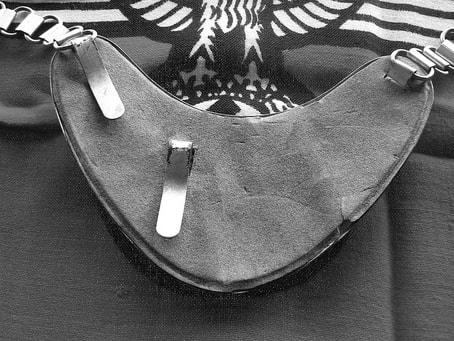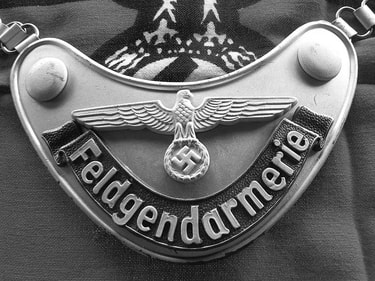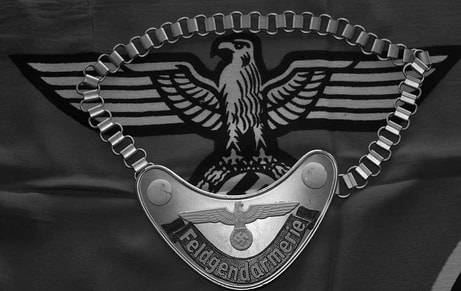|
Darwin war history
Ringkragen12/4/2018 AuthorWritten by Craig Wharton.
The Ringkragen was the Feldgendarmerie badge of office and gave the wearer considerable authority. The Ringkragen was made of stamped steel in a crescent shape with rounded points. In a grey metal colour it had a raised edge for added strength. Securing the neck chain at either side was a slightly pebbled button. In the center, a spread-winged eagle clutching a wreath is surrounding the swastika, both painted in a greenish yellow luminous paint. Below sits a banner scroll in dark grey with the word ‘Feldgendarmerie’ in the same luminous paint. The neck chain had plain flat links. This gorget measures 6.5 inches (165mm) at its widest point and 4.25 inches (108mm) in depth. As well as the Ringkragen the Feldgendarmerie also wore a cuff title bearing that name in Gothic script in grey letters on a brown background. An embroidered police eagle within an oakleaf wreath arm badge was worn on the upper left sleeve of the tunic. In the orange-red ‘waffenfarbe’ (arm of service colour) for Other Ranks and in silver for Officers. This waffenfarbe was also found on the cap, collar litzen and as the underlay colour on the ‘schulterklappen’ (epaulets).  On the reverse side it was covered in a field grey cloth backing or a card type backing. This example is the card type. A tang mounted to the rear, just off center, was for slipping into the button hole of the tunic to secure the Ringkragen to the chest. Another tang on the rear left hand side as you view it from the rear was to hook the other end of The German Feldgendarmerie (MP) had traditions dating back to 1740 when Friedrich II established the Feld-Jager Korps zu Pferd. The Feld-Jager Korps established a reputation for efficiency during the Napoleonic Wars and the Franco -Prussian War. The German civilian police, the Gendarmerie, established its own military branch, the Feldgendarmerie, which served alongside the Feld-Jager Korps. In time it outgrew the Feld- Jager Korps and took over the role of Germany's principal provost arm. Both the Feldgendarmerie and the Feld-Jager Korps served with distinction during World War I but were disbanded at the end of the war. There were no military police units in the German Army between 1919 and 1939. The Feldgendarmerie was reformed in 1939 when the German Army mobilized for war. The tasks the Feldgendarmerie were called upon to perform were much the same as military police do in any army: control of traffic to and from the front line, maintenance of order and discipline, rounding up stragglers, arresting deserters and looters, interrogation of suspects, anti-partisan patrols, escorts for prisoners, manning checkpoints and checking IDs and travel passes as well as general policing duties. Although they did carry out some traffic control duties, these were the real "head hunters." In the closing stages of the war they were tasked with rounding up stragglers and any man, or boy, fit enough to hold a rifle or a Panzerfaust. They packed these unfortunates off to the front line to try and stem the unstoppable Russian advance. Their power was absolute and any man suspected of being a deserter could be summarily executed by shooting or hanging. A common scene in the crumbling Third Reich was that of a soldier hanging from a convenient lamp post with a sign around his neck proclaiming his desertion and disloyalty to Reich and Fuhrer. Authorized to settle any dispute at the point of a gun they often did. They held the power of life and death and used it as they saw fit. At war's end the Allies own military police services were stretched to the limit. They retained a large number of these Feldgendarmerie and Feld-Jager Korps as armed auxiliary formations to help them keep law and order in Germany following the German surrender. They did not lay down their arms till several months after the rest of the German Army had surrendered. Apart from the two formations already covered above, there were other Ringkragen used by German forces. There was a standard (flag) bearers’ version for ceremonial occasions and other gorgets for auxiliary police patrols in garrisons and in railway stations. These differed by not having an eagle central to the gorget. The Luftwaffe (German airforce) military police had a Ringkragen identical to the Army one except for the eagle, which is the Luftwaffe eagle in flight. This gorget was only worn by members of the Herman Goering Division. Other Luftwaffe Feldgendarmerie utilized the standard Army gorget. Strangely enough, the Waffen SS, who had their own distinctive uniforms and insignia for any and all occasions, did not have a Ringkragen of their own design and also used the standard Army model. The other Ringkragen are very rare these days but because the Feldgendarmerie were such a large formation within the German Army there are naturally more of them to go round. Even so these things are still quite rare with only one or two coming on the collector's market each year. They command a high price, usually around $1,500 to $2,000. The traditional Ringkragen and cuff title are no longer in use. Connections to the Third Reich period and excesses committed then are probably the reason for this change. Today the Feld-Jager are recognisable by their white belt and holster and like their British counterparts, the red beret of the Corp of Military Police. A white armband bearing the title Feld-Jager is worn on the arm. The traditions of the Imperial German Feld-Jager Korps are being preferred to the tarnished record of the Feldgendarmerie between 1939 and 1945.
wwII history
0 Comments
Leave a Reply.Darwin Military Museum
|
How to Contact and find the Darwin Military Museum
Click on Address: LOT 5434 Alec Fong Lim Dr, East Point NT 0820
|
|
Check out Facebook!
|
Find out more |
Darwin Military Museum
OPENING TIMES & TICKETS
Please note we are closed on the following days:
Sun 24th - Tues 26th Dec 23 (inclusive)
Sun 31st Dec - Mon 1st Jan 24 (inclusive)
Closed: Good Friday, Easter Sunday, Christmas, Boxing and New Years days.
- Please note we will be open from 10 - 3 on Easter Saturday
OPENING TIMES 7 days a Week
(refer above for exceptions)
9.30am - 4pm Monday - Saturday
10.00am - 3pm Sunday and public holidays
We recommend you allow at least 1.5hrs for your visit.
ADMISSION FEES & ONLINE TICKETS
(Proof of id/concession required for Pensioner (65+), Uni/TAFE student, Veteran, Serving Military Member and Disability/Carer)
ADULTS (16 years +): $20.00
CHILDREN (5 - 15 years): $10.00
CHILDREN (under 5 years): FREE
FAMILY PASS (2 ADULTS, 3 CHILDREN U16): $45.00
PENSIONER (65 years +): $15.00
UNIVERSITY/TAFE STUDENT: $15.00
COMPANION CARD HOLDER AND PERSON WITH A DISABILITY: $20.00
VETERANS: $15.00
SERVING MILITARY MEMBERS: $15.00
SCHOOL GROUPS: Northern Territory students on excursion Students 16 years and under during school hours: $5.00 per student. Students must be supervised at all times. 1 adult per 10 students: $20.00
SCHOOL GROUPS: Non-NT students on excursion
Students 16 years and under during school hours: $10.00 per student. Students must be supervised at all times.
1 adult per 10 students: $20.00
Please note we are closed on the following days:
Sun 24th - Tues 26th Dec (inclusive)
Sun 31st Dec - Mon 1st Jan (inclusive)
For hotels nearby, check with HotelsCombined


 RSS Feed
RSS Feed





